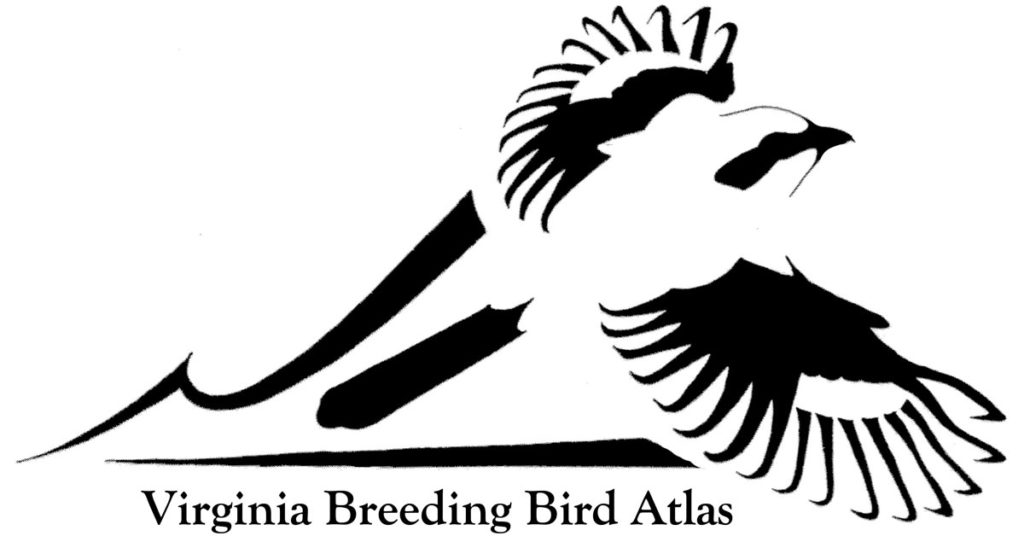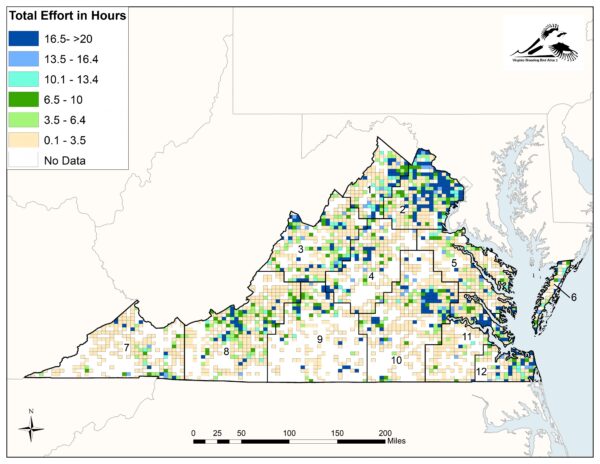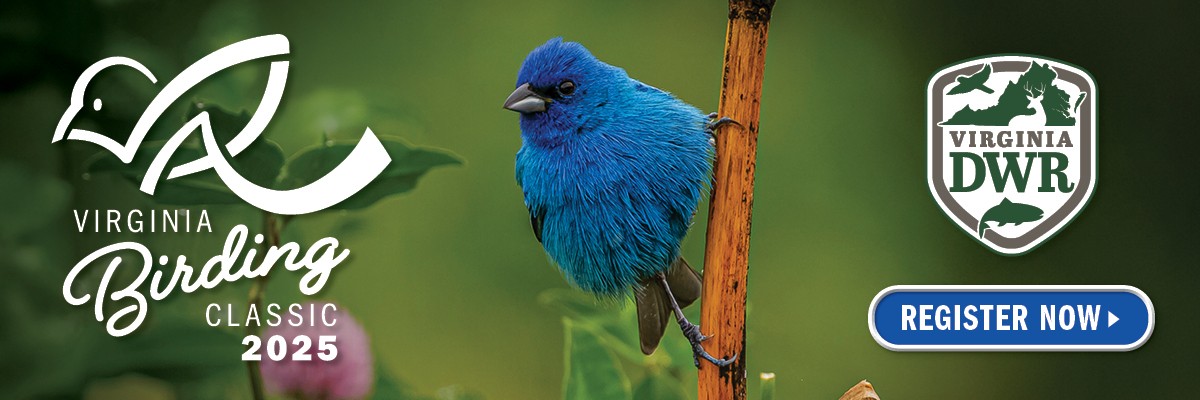By Ashley Peele, PhD, Virginia Breeding Bird Atlas Coordinator
 In 2018, we waved hello and goodbye to the halfway point for this project and are now blazing ahead toward the finish line in 2020. As we look toward year four, we will be pushing out new resources to help guide volunteers for our last two field seasons. For now though, we would like to turn our attention to the accomplishments of VABBA2 and it’s many volunteers in 2018! The VABBA2’s seasonal summary describes many interesting highlights, so please download here (Season2018Summary_Final.pdf) and share with your birding friends and family. The highlights mentioned below overlap, in part, with this summary.
In 2018, we waved hello and goodbye to the halfway point for this project and are now blazing ahead toward the finish line in 2020. As we look toward year four, we will be pushing out new resources to help guide volunteers for our last two field seasons. For now though, we would like to turn our attention to the accomplishments of VABBA2 and it’s many volunteers in 2018! The VABBA2’s seasonal summary describes many interesting highlights, so please download here (Season2018Summary_Final.pdf) and share with your birding friends and family. The highlights mentioned below overlap, in part, with this summary.
Season Three Highlights
The Cornell Lab of Ornithology recently shared an exciting statistic on the reporting of breeding bird information in Virginia, pre- and post-BBA2. Here are the figures:
In 2015, only 4,597 breeding observations were reported in Virginia
In the first year of the VABBA2 (2016), birders reported 89,148 breeding observations (a 2000% increase!)
In 2018, birders reported 136,428 breeding observations to the VABBA2, a 3000% increase from pre-VABBA2 eBird submissions!
We hope you find these numbers as phenomenal as the VABBA2 leadership. The annual increase in breeding observations (i.e. breeding codes) paints a clear picture of Virginia birders willingness to adapt their usual birding routines. Simply by taking the time to log their breeding observations to the VABBA2 eBird portal, our volunteers have taken us much closer to our primary goal of documenting the statewide distribution and status of breeding bird populations in the Commonwealth.
A second significant benchmark achieved in 2018 was the completion of 120+ Priority blocks (PBs), as well as a 20% increase in statewide priority block survey time. Much of this increase is a result of local blockbusters (folks who spend one or more days intensively surveying a PB with little to no data) and clubs who organized blockbusting trips to under-surveyed regions. *Please see a list of special thanks at the end of this article.
Species Highlights
Nocturnal Species
Nocturnal bird survey time has been on the rise, since the first VABBA2 field season in 2016. In fact, nocturnal effort has increased more than 250% from 2016-2018. Volunteers report increasingly higher numbers of breeding codes for both owl and nightjar species (see Figures 1a and 1b below), though we note that these reports are not limited to nighttime observations. For example, the first VABBA2 breeding confirmation for Chuck-Will’s-Widows documented by Matt Anthony and Erin Chapman in Lee County, June 2018. Lee county is one of the project’s least surveyed counties, but this exciting find illustrates how much opportunity awaits intrepid birders in the remote, but beautiful corner of southwest VA.


Figures 1a and 1b. Annual Breeding Code Reports for Owls and Nightjars.
Nocturnal species typically represent one of the most under-reported subsets of breeding birds in any given Atlas. The reasons for this are obvious. It can be difficult to detect nocturnal species in the daytime, while nighttime work is a challenge. However, Atlas volunteers helped to close out many Priority blocks this year by committing to nocturnal surveys. We encourage able and willing volunteers to log nighttime surveys in their own blocks or to help a friend survey theirs. A buddy-system is strongly encouraged, when surveying at night!
Missing Species of the Piedmont
As the Barn Swallow map on our 2018 summary illustrates, many common species are dramatically underrepresented in the Piedmont. Similar gaps exist for species like Yellow Warbler, Brown-headed Nuthatch, Blue Grosbeak, and Red-headed Woodpecker. All of which are species with negative population trajectories for most of the eastern US. This makes it all the more important for us to better understand their current distribution and status of these species within Virginia. Accurate assessment will not be possible without better survey coverage in the southern regions of Virginia. So, let us now look ahead to 2019…
Regional Spotlight for Season Four
The latest Atlas effort map (Figure 3) clearly illustrates where the bulk of Atlas bird survey effort needs to focus in 2019. Large regional birding communities, or in some cases a dedicated few, have done a fantastic job of surveying priority blocks throughout much of Virginia. Dark green counties illustrate plainly where birders live or frequently travel to. However, if this project is to accurately document breeding distributions across all of Virginia, attention must now turn toward the light green central and southern counties.

Figure 3. Map of statewide Priority block coverage, October 2018.
These southern regions have spectacular habitats for birds, but they also have many of the lowest human population densities in the state. This creates an opportunity for intrepid birders, looking to a make a big impact for the VABBA2 project. A few days spent logging breeding data in Priority Blocks in Halifax, Caroline, or Tazewell counties can represent a leap forward for these regions.
To conclude for now, we wanted acknowledge and thank a few of our 1000+ Atlas volunteers…
First, these Atlas volunteers have each contributed more than 1000(!) complete checklists to the VABBA2 eBird portal since 2016:
Kelly Krechmer, Carlton Noll, Diane Holsinger, and Evan Spears.
Thanks so much for the time and effort you have invested in this project.
This batch of volunteers have each confirmed more than 90 species of breeding birds in VA:
Ellison Orcutt, Kurt Gaskill, David Larsen, Diane Holsinger, Kelly Krechmer, James Fox, Candice Lowther, Bob Epperson, and John Spahr
We know the care, attention, and persistence required to observe breeding evidence for this many species, so thanks to you all for your dedication.
Finally, a big thanks to the VA birders who went out of their way to help us get breeding bird data into under-surveyed Priority Blocks in rural VA…
- Central VA blockbusters, Guy and Susan Babineau and many other members of the Monticello Bird Club
- Steve Johnson and Lynn Rafferty, who trekked from NoVA to far Southwest VA to blockbust remote PBs over their summer weekends
- Kurt Gaskill and the Northern VA birding community who have nearly completed their own region’s Priority blocks and are now setting their sites on rural areas in need of blockbusting
- Richmond Audubon Society, who hosted blockbusting weekends to help get birders out into the some of the many ‘PBs in need’ in the southern Piedmont
- Diane Lepkowski and the Rockingham County Bird Club, who helped pitch in to lead many Atlas-themed field trips for this year’s annual VSO conference AND have blitzed to cover many of their regions remote PBs
- Cheryl Jacobson, who has led the charge for the Williamsburg Bird Club from day one
Lastly, thanks to each of our Regional Coordinators, who continue to help keep this project moving forward toward the finish line!
Any to the many, many other volunteers we have not yet mentioned, thank you! **
**If you or your group are involved in PB surveying and/or blockbusting activities and were not mentioned here, please let us know what you have done and are planning to do in the upcoming field season! Shoot us an email or Facebook message (www.facebook.com/groups/vabba2). If you’d like more guidance on how to host a blockbusting event or just start helping to survey PBs in your neck of the woods, again, please reach out to your regional coordinator whose contact info can be found at http://amjv.org/vabba/contacts/.


